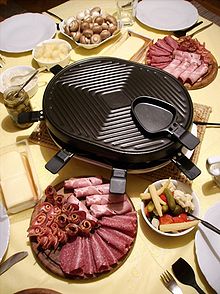Last night we enjoyed the company of our neighbours, Julie and Terry, with their children Esme and Merlin (12 and 7 respectively). Whenever younger people are involved, it’s always best to find something simple that will capture their imaginations, so we decided to do a Raclette, which is a dish created in Switzerland where, originally, cheese was heated in front of a fire then the melted cheese was scraped from the unmelted part of the cheese onto the diners’ plates (the term raclette derives from the French verb racler, meaning “to scrape”). The cheese is accompanied by small firm potatoes, gherkins, pickled onions, and dried meat, such as raw smoked hams and viande des Grisons (beef).
 Obviously, we didn’t buy a 50kg block of cheese, light a fire and start scraping it – we used a more modern way of serving raclette that involves an electric table-top grill with small pans, known as coupelles, in which to melt slices of cheese. When we do this, we bring the cheese to the table already cut and sliced, along with a plate of charcuterie like Grisons (which is what we used last night) or pastrami or salami or cooked ham (or whatever floats your boat) accompanied by a big dish of boiled or steamed potatoes and a bowl of cornichons (small gherkins).
Obviously, we didn’t buy a 50kg block of cheese, light a fire and start scraping it – we used a more modern way of serving raclette that involves an electric table-top grill with small pans, known as coupelles, in which to melt slices of cheese. When we do this, we bring the cheese to the table already cut and sliced, along with a plate of charcuterie like Grisons (which is what we used last night) or pastrami or salami or cooked ham (or whatever floats your boat) accompanied by a big dish of boiled or steamed potatoes and a bowl of cornichons (small gherkins).
Diners place a slice of cheese in their coupelle, slide it under the grill to melt and, meanwhile, help themselves to potatoes, meat and cornichons. As soon as the cheese is melted it is simply “poured” over the food on your plate (with a bit of help from small wooden spatulas if necessary). Then you load your coupelle with cheese again and pop it under the grill to melt while you are eating what’s on your plate. It’s like a mini production line, the emphasis being on relaxed and sociable eating and drinking.
And, just for fun, we had brought some purple Vitelotte Potatoes back from France with us, which we mixed with normal white potatoes to create a splash of colour. We had also brought back with us some packs of ready-cut cheese that are specifically intended for raclettes. However, you can use almost any firm cheese (particularly Port Salut – a semi-soft pasteurised cow’s milk cheese from Pays de la Loire, France, with a distinctive orange crust and a mild flavour). As a guide, there were 4 adults and two youngsters last night and we ate 750g (just under 1¾lb) of cheese.
French and other European supermarkets generally stock both the grill apparatus and ready-sliced cheese and charcuterie selections. However, elsewhere in the world you can buy the grills online at places like Amazon (just search under raclette). The other fun aspect of modern raclette grills is that they incorporate a hot stone, so you can have a “cook your own meat” evening too (which we often do). If you buy your cheese as a block, you need to cut and slice it to create pieces roughly 5cm x 7cm x 6mm (2″ x 2¾” x ¼”)
Last night, just for fun, we also put a few uncooked quail’s eggs on the table and some of us played making “omelette on cheese” just for the hell of it (told you it was all about relaxed and sociable eating!). Thought it’s not essential, we also provided little side salads of baby leaves, raw mushrooms, clementines and a vinagrette that used tomato ketchup! We served a Pinot Noir from Alsace that is light enough to complement the somewhat heavy cheese. Afterwards, we indulged in Bruno’s Double Take Apple Flan, which is light and delicious! (Hazard warning!!! Don’t serve ice cream after a raclette; it will solidify the cheese in your stomach and you’ll feel like you’ve eaten a barrow load of lead!)
So we arrived at lunch time today wondering what to eat and decided on a “left-overs” salad of Grisons (left-over), potatoes (left-over), mushrooms (left-over), quail’s eggs (left-over) and spring onions. M-D had her potatoes as a Warm Potato Salad while I just had mine sliced and cold. And we both added a little Thousand Island Dressing to the raw mushrooms… delicious! Tonight will be just soup, I suspect – I rather overdid the cheese last night!